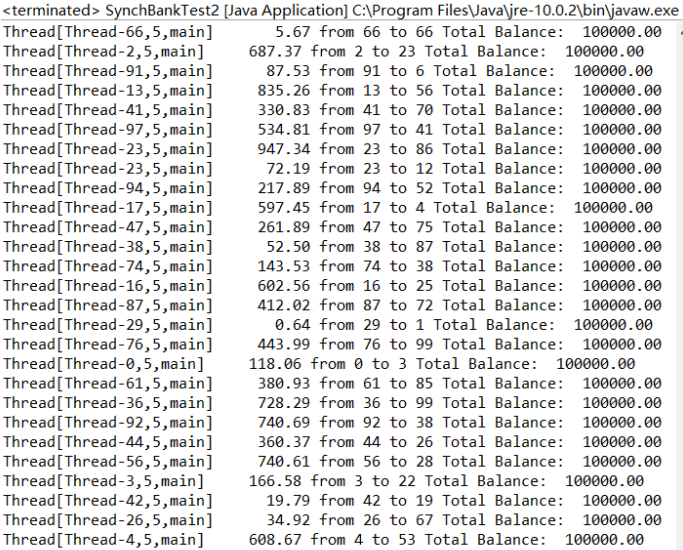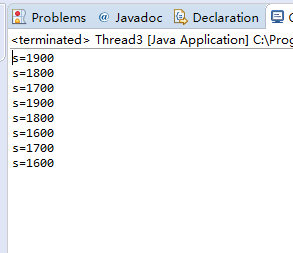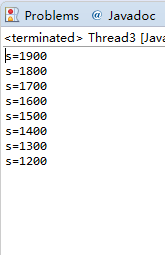周強 201771010141面向物件程式設計(java)》第十七週學習總結
執行緒同步
多執行緒併發執行不確定性問題解決方案:引入線 程同步機制,使得另一執行緒要使用該方法,就只 能等待。
⚫ 在Java中解決多執行緒同步問題的方法有兩種:
1.- Java SE 5.0中引入ReentrantLock類(P648頁)。
2.- 在共享記憶體的類方法前加synchronized修飾符。
……
public synchronized static void sub(int m)
……
解決方案一:鎖物件與條件物件
用ReentrantLock保護程式碼塊的基本結構如下:
myLock.lock();
try {
critical section
} finally{
myLock.unlock(); }
有關鎖物件和條件物件的關鍵要點:
➢ 鎖用來保護程式碼片段,保證任何時刻只能有一 個執行緒執行被保護的程式碼。
➢ 鎖管理試圖進入被保護程式碼段的執行緒。
➢ 鎖可擁有一個或多個相關條件物件。
➢ 每個條件物件管理那些已經進入被保護的程式碼 段但還不能執行的執行緒。
解決方案二: synchronized關鍵字
synchronized關鍵字作用:
➢ 某個類內方法用synchronized 修飾後,該方法被稱為同步方法;
➢ 只要某個執行緒正在訪問同步方法,其他執行緒欲要訪問同步方法就被阻塞,直至執行緒從同步方法返回前喚醒被阻塞執行緒,其他執行緒方可能進入同步方法。
➢ 一個執行緒在使用的同步方法中時,可能根據問題的需要,必須使用wait()方法使本執行緒等待,暫時讓出CPU的使用權,並允許其它執行緒使用這個同步方法。
➢ 執行緒如果用完同步方法,應當執行notifyAll()方 法通知所有由於使用這個同步方法而處於等待的 執行緒結束等待。
第二部分:實驗部分——執行緒同步控制
實驗時間 2018-12-10
1、實驗目的與要求
(1) 掌握執行緒同步的概念及實現技術;
(2) 執行緒綜合程式設計練習
2、實驗內容和步驟
實驗1:測試程式並進行程式碼註釋。
測試程式1:
1.在Elipse環境下除錯教材651頁程式14-7,結合程式執行結果理解程式;
2.掌握利用鎖物件和條件物件實現的多執行緒同步技術。
package synch;
import java.util.*;
import java.util.concurrent.locks.*;
/**
一個銀行有許多銀行帳戶,使用鎖序列化訪問 * @version 1.30 2004-08-01
* @author Cay Horstmann
*/
public class Bank
{
private final double[] accounts;
private Lock bankLock;
private Condition sufficientFunds;
/**
* 建設銀行。
* @param n 賬號
* @param initialBalance 每個賬戶的初始餘額
*/
public Bank(int n, double initialBalance)
{
accounts = new double[n];
Arrays.fill(accounts, initialBalance);
bankLock = new ReentrantLock();
sufficientFunds = bankLock.newCondition();
}
/**
* 把錢從一個賬戶轉到另一個賬戶。
* @param 從賬戶轉賬
* @param 轉到要轉賬的賬戶
* @param 請允許我向你轉達
*/
public void transfer(int from, int to, double amount) throws InterruptedException
{
bankLock.lock();
try
{
while (accounts[from] < amount)
sufficientFunds.await();
System.out.print(Thread.currentThread());
accounts[from] -= amount;
System.out.printf(" %10.2f from %d to %d", amount, from, to);
accounts[to] += amount;
System.out.printf(" Total Balance: %10.2f%n", getTotalBalance());
sufficientFunds.signalAll();
}
finally
{
bankLock.unlock();
}
}
/**
* 獲取所有帳戶餘額的總和。
* @return 總餘額
*/
public double getTotalBalance()
{
bankLock.lock();
try
{
double sum = 0;
for (double a : accounts)
sum += a;
return sum;
}
finally
{
bankLock.unlock();
}
}
/**
* 獲取銀行中的帳戶數量。
* @return 賬號
*/
public int size()
{
return accounts.length;
}
}
package synch;
/**
* 這個程式顯示了多個執行緒如何安全地訪問資料結構。
* @version 1.31 2015-06-21
* @author Cay Horstmann
*/
public class SynchBankTest
{
public static final int NACCOUNTS = 100;
public static final double INITIAL_BALANCE = 1000;
public static final double MAX_AMOUNT = 1000;
public static final int DELAY = 10;
public static void main(String[] args)
{
Bank bank = new Bank(NACCOUNTS, INITIAL_BALANCE);
for (int i = 0; i < NACCOUNTS; i++)
{
int fromAccount = i;
Runnable r = () -> {
try
{
while (true)
{
int toAccount = (int) (bank.size() * Math.random());
double amount = MAX_AMOUNT * Math.random();
bank.transfer(fromAccount, toAccount, amount);
Thread.sleep((int) (DELAY * Math.random()));
}
}
catch (InterruptedException e)
{
}
};
Thread t = new Thread(r);
t.start();
}
}
}

測試程式2:
l 在Elipse環境下除錯教材655頁程式14-8,結合程式執行結果理解程式;
l 掌握synchronized在多執行緒同步中的應用。
實驗程式碼:
package synch2;
import java.util.*;
/**
* A bank with a number of bank accounts that uses synchronization primitives.
* @version 1.30 2004-08-01
* @author Cay Horstmann
*/
public class Bank
{
private final double[] accounts;
/**
* Constructs the bank.
* @param n the number of accounts
* @param initialBalance the initial balance for each account
*/
public Bank(int n, double initialBalance)
{
accounts = new double[n];
Arrays.fill(accounts, initialBalance);
}
/**
* Transfers money from one account to another.
* @param from the account to transfer from
* @param to the account to transfer to
* @param amount the amount to transfer
*/
public synchronized void transfer(int from, int to, double amount) throws InterruptedException
{
while (accounts[from] < amount)
wait();
System.out.print(Thread.currentThread());
accounts[from] -= amount;
System.out.printf(" %10.2f from %d to %d", amount, from, to);
accounts[to] += amount;
System.out.printf(" Total Balance: %10.2f%n", getTotalBalance());
notifyAll();
}
/**
* Gets the sum of all account balances.
* @return the total balance
*/
public synchronized double getTotalBalance()
{
double sum = 0;
for (double a : accounts)
sum += a;
return sum;
}
/**
* Gets the number of accounts in the bank.
* @return the number of accounts
*/
public int size()
{
return accounts.length;
}
}
package synch2;
/**
* This program shows how multiple threads can safely access a data structure,
* using synchronized methods.
* @version 1.31 2015-06-21
* @author Cay Horstmann
*/
public class SynchBankTest2
{
public static final int NACCOUNTS = 100;
public static final double INITIAL_BALANCE = 1000;
public static final double MAX_AMOUNT = 1000;
public static final int DELAY = 10;
public static void main(String[] args)
{
Bank bank = new Bank(NACCOUNTS, INITIAL_BALANCE);
for (int i = 0; i < NACCOUNTS; i++)
{
int fromAccount = i;
Runnable r = () -> {
try
{
while (true)
{
int toAccount = (int) (bank.size() * Math.random());
double amount = MAX_AMOUNT * Math.random();
bank.transfer(fromAccount, toAccount, amount);
Thread.sleep((int) (DELAY * Math.random()));
}
}
catch (InterruptedException e)
{
}
};
Thread t = new Thread(r);
t.start();
}
}
}

測試程式3:
l 在Elipse環境下執行以下程式,結合程式執行結果分析程式存在問題;
l 嘗試解決程式中存在問題。
class Cbank
{
private static int s=2000;
public static void sub(int m)
{
int temp=s;
temp=temp-m;
try {
Thread.sleep((int)(1000*Math.random()));
}
catch (InterruptedException e) { }
s=temp;
System.out.println("s="+s);
}
}
class Customer extends Thread
{
public void run()
{
for( int i=1; i<=4; i++)
Cbank.sub(100);
}
}
public class Thread3
{
public static void main(String args[])
{
Customer customer1 = new Customer();
Customer customer2 = new Customer();
customer1.start();
customer2.start();
}
}

修改之後如下:
import javax.sql.rowset.spi.SyncFactory;
class Cbank
{
private static int s=2000;
public synchronized static void sub(int m)
{
int temp=s;
temp=temp-m;
try {
Thread.sleep((int)(1000*Math.random()));
}
catch (InterruptedException e) { }
s=temp;
System.out.println("s="+s);
}
}
class Customer extends Thread
{
public void run()
{
for( int i=1; i<=4; i++)
Cbank.sub(100);
}
}
public class Thread3
{
public static void main(String args[])
{
Customer customer1 = new Customer();
Customer customer2 = new Customer();
customer1.start();
customer2.start();
}
}

實驗2 程式設計練習
利用多執行緒及同步方法,編寫一個程式模擬火車票售票系統,共3個視窗,賣10張票,程式輸出結果類似(程式輸出不唯一,可以是其他類似結果)。
Thread-0視窗售:第1張票
Thread-0視窗售:第2張票
Thread-1視窗售:第3張票
Thread-2視窗售:第4張票
Thread-2視窗售:第5張票
Thread-1視窗售:第6張票
Thread-0視窗售:第7張票
Thread-2視窗售:第8張票
Thread-1視窗售:第9張票
Thread-0視窗售:第10張票
package xaincheng;
import java.nio.charset.MalformedInputException;
public class Demo {
public static void main(String[] args)
{
Mythread mythread= new Mythread();
Thread t1 = new Thread(mythread);
Thread t2 = new Thread(mythread);
Thread t3 = new Thread(mythread);
t1.start();
t2.start();
t3.start();
}
}
class Mythread implements Runnable{
int t=1;
boolean flag=true;
public void run() {
while(flag) {
try {
Thread.sleep(500);
}
catch (InterruptedException e)
{
e.printStackTrace();
}
synchronized (this) {
if(t<=10){
System.out.println(Thread.currentThread().getName()+"視窗售:第"+t+"張票");
t++;
}
if(t>10){
flag=false;
}
}
}
}
}

實驗總結:通過本學期對Java這門課程的學習收穫了很多,也很感謝老師還有助教學長對我們無微不至的關心,也通過這次試驗加深了對多執行緒的理解,知道了併發多執行緒的解決方法。
